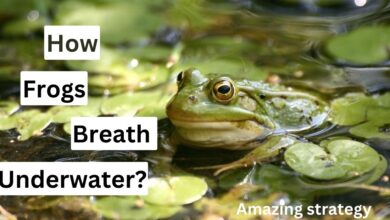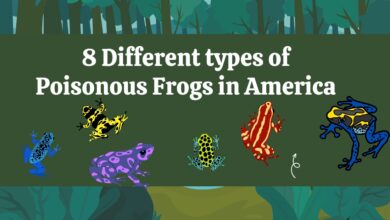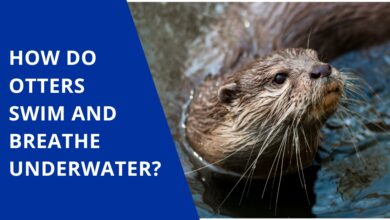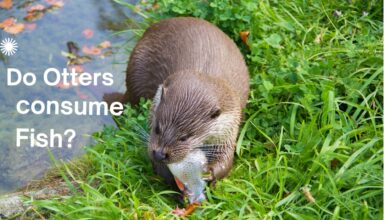15 different types of amphibians other than Frogs
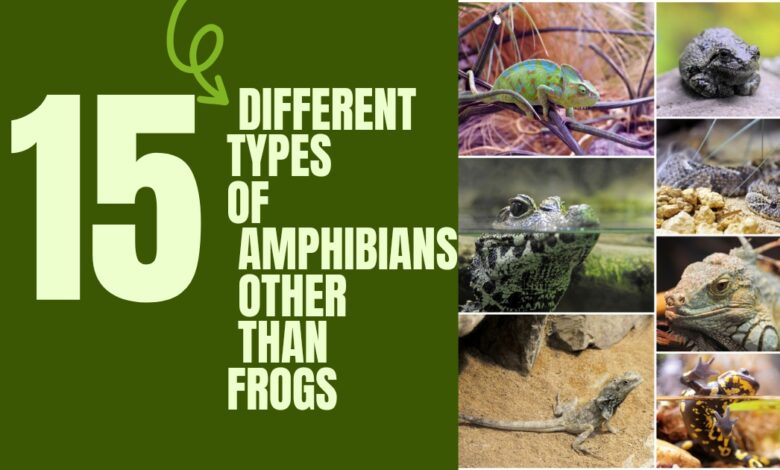
15 different types of amphibians other than Frogs
Amphibians are cool animals that can live both in water and on land. Frogs, toads, salamanders, and newts are all part of the amphibian family.
They often start their lives in water as tadpoles with tails, then transform into adults that can hop, crawl, or even climb trees.
Amphibians are important for the environment and come in various shapes and sizes, bringing a unique charm to the animal world with their ability to adapt to different habitats.
15 different types of amphibians other than Frogs are discussed here:
1. Salamanders
Salamanders, known for their slender bodies and smooth, moist skin, exhibit a remarkable feature that sets them apart. One of the most unique qualities of salamanders is their extraordinary ability to regenerate lost body parts. Unlike many other creatures, salamanders can regrow limbs, tails, and even parts of their heart and brain.
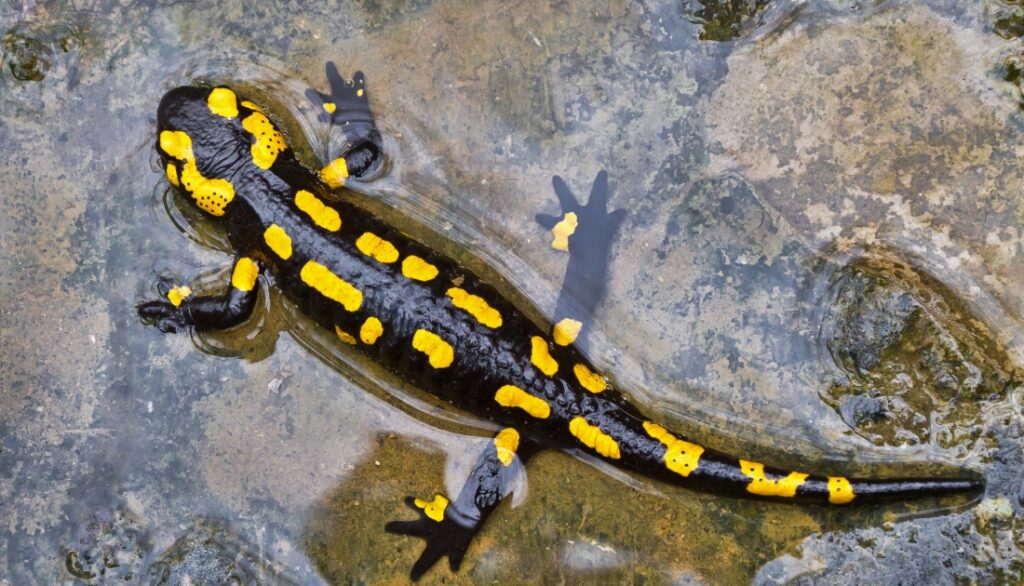
These amphibians come in various sizes and colors, from the tiny and brightly-hued Eastern Newt to the larger and more cryptically colored Tiger Salamander. Their diverse habitats range from terrestrial environments to freshwater ecosystems, showcasing adaptability. Salamanders also play crucial roles in ecological balance.
2. Newts
Newts, a subgroup of salamanders, captivate with their unique characteristics. These amphibians are renowned for their distinctive life stages, undergoing metamorphosis from aquatic larvae to terrestrial adults. One remarkable feature is their ability to regenerate lost limbs, a trait shared with other salamanders.
Notable among newts is the strikingly vibrant Eastern Newt, with its eye-catching orange coloration during the terrestrial eft stage. Some newt species, like the Great Crested Newt, display elaborate courtship rituals, involving impressive displays to attract mates.
These fascinating creatures are found in various habitats, from woodlands to ponds. Despite their small size, newts play essential roles in maintaining ecological balance by controlling insect populations and contributing to the diversity of their ecosystems.
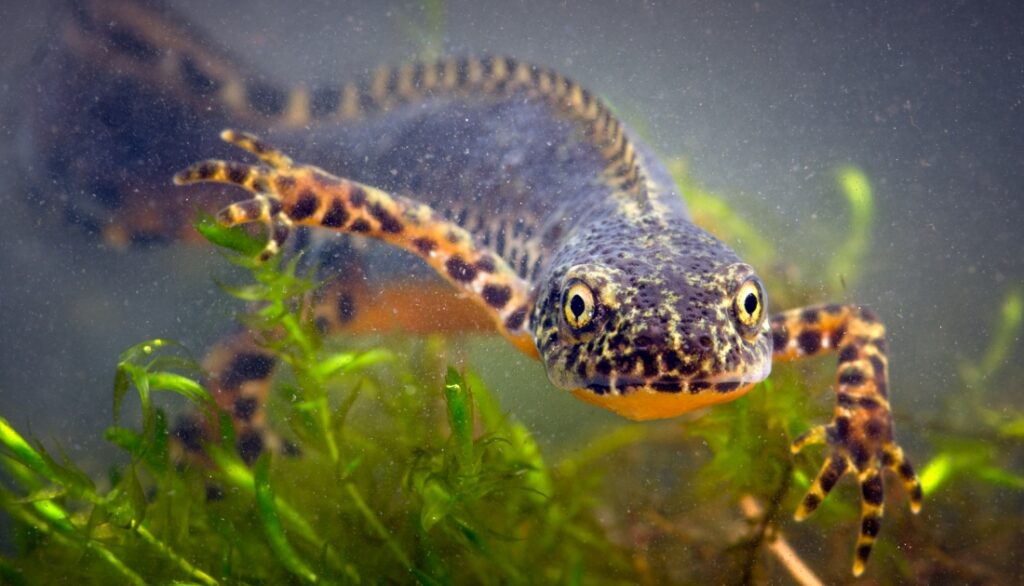
3. Toads
Toads, a subgroup of amphibians, exhibit remarkable characteristics that set them apart in the world of croak and leap. Unlike frogs, toads possess distinct adaptations for survival. Their dry, bumpy skin acts as a protective shield, often containing toxins to deter predators.
One of the most intriguing features of toads is their ability to tolerate drier environments compared to other amphibians. They can be found in diverse habitats, from arid deserts to lush forests. Toads lay eggs in long strings, a departure from the clustered egg masses of many frogs.
See Also: How frogs breath underwater? (Amazing strategy)
Toad tadpoles undergo metamorphosis, transforming into terrestrial adults. These hardy creatures play essential roles in ecosystems by controlling insect populations, making them valuable allies in gardens and natural habitats.
4. Caecilians
Caecilians, often overshadowed by their more well-known amphibian counterparts, present a fascinating and enigmatic group within the order Gymnophiona. Distinguished by their serpent-like appearance and hidden lifestyle, caecilians bring a distinctive touch to the diverse world of amphibians.
Contrary to frogs and salamanders, caecilians lack limbs, appearing as elongated and smooth creatures. Most intriguingly, many species display a remarkable adaptation known as dermatophagy, where they consume their own shed skin for added nutrients.
These amphibians predominantly inhabit tropical regions, often dwelling in underground burrows or moist soils. The eyes of caecilians are typically reduced or even covered, emphasizing their reliance on other senses for navigation.
5. Axolotls
Meet the axolotl, an extraordinary creature renowned for its remarkable regenerative abilities and distinctive appearance. Native to the ancient lake complex of Xochimilco in Mexico, these aquatic salamanders exhibit traits that set them apart in the amphibian world.
Axolotls possess an exceptional capacity for regeneration, able to regrow entire limbs, spinal cord, heart, and even parts of their brain throughout their lives. This ability makes them a subject of extensive scientific interest, as researchers explore the potential applications for human tissue regeneration.
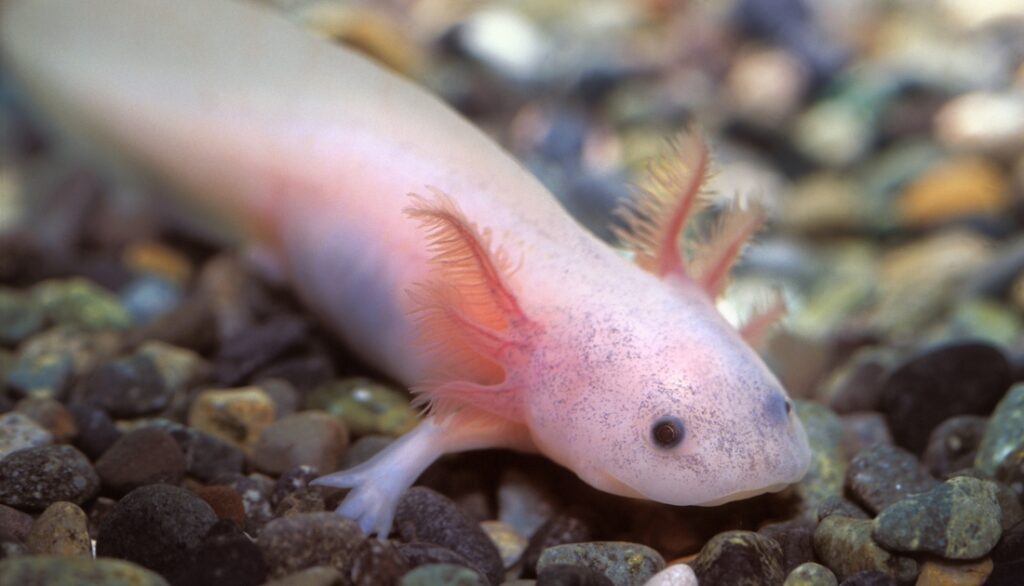
While facing challenges in their natural habitat due to urbanization, axolotls thrive in captivity, making them not only biological wonders but also beloved companions for amphibian enthusiasts worldwide.
6. Hellbenders
Enter the realm of North America’s aquatic giants, the Hellbenders, fascinating salamanders known for their impressive size and aquatic prowess. These creatures, belonging to the Cryptobranchidae family, are endemic to freshwater streams in the eastern United States.
Hellbenders are renowned for their substantial size, with some individuals reaching lengths of up to 29 inches (74 cm). Their flattened bodies and loose, wrinkled skin enhance their streamlined appearance, aiding in their aquatic lifestyle.
Thriving in cool, fast-flowing streams, Hellbenders are specially adapted to their aquatic habitats. They boast intricate folds of skin, which increase their surface area, enabling efficient respiration through their skin. As lungless salamanders, they rely on cutaneous respiration, absorbing oxygen directly through their skin.
See Also: How great white shark bite is so powerful?
7. Fire Salamanders
Step into the mystical world of the Fire Salamander, a captivating amphibian species found in the lush woodlands of Europe. These striking creatures, scientifically known as Salamandra salamandra, are renowned for their vivid black bodies adorned with vibrant yellow markings.
Fire Salamanders are relatively large amphibians, measuring around 6 to 10 inches (15 to 25 cm) in length. Their distinctive coloration serves as a warning to potential predators, signaling the presence of toxic substances in their skin secretions. These toxins, including alkaloids and other chemical compounds, act as a formidable defense mechanism against predators.
One of the fascinating aspects of Fire Salamanders is their unique courtship ritual. During the breeding season, males engage in an intricate dance to attract females. Once courtship is successful, females deposit clusters of eggs in damp crevices or under rocks, where they eventually hatch into aquatic larvae.
8. Surinam Toads
Dive into the enchanting realm of Surinam Toads (Pipa pipa), where nature unfolds a truly unique and captivating tale. These fascinating amphibians, native to the rainforests of South America, are renowned for their extraordinary method of reproduction.
One of the most striking features of Surinam Toads lies in their flattened bodies, resembling a leaf or pancake. This aquatic species has evolved a specialized reproductive strategy known as “dermal incubation,” setting them apart from many other amphibians.
During courtship, male Surinam Toads produce clicking sounds to attract females. Once a pair forms a connection, the female releases her eggs, and the male fertilizes them externally. Here’s where the magic unfolds – the fertilized eggs are embedded in the skin on the female’s back. The skin then envelops the eggs, forming pockets that resemble a honeycomb.
9. Amphiumas
Meet the Amphiumas, enigmatic creatures that navigate the waters with a serpentine grace, adding a touch of mystery to the wetlands of North America. These limbless amphibians belong to the family Amphiumidae and are often referred to as “congo eels” due to their elongated bodies and eel-like appearance.
Distinguishing features of Amphiumas include their lack of external gills and reduced limbs, making them well-suited for their predominantly aquatic lifestyle. These remarkable amphibians possess smooth, slimy skin and can range in color from dark brown to olive or gray, blending seamlessly into their aquatic environments.
One of the most intriguing aspects of Amphiumas lies in their unusual reproductive behavior. Instead of the traditional external egg-laying approach seen in many amphibians, these creatures engage in internal fertilization. The male uses specialized structures called spermatophores to transfer sperm directly to the female, contributing to their unique reproductive strategy.
10. Olms
Dwelling in the depths of subterranean worlds, Olms (Proteus anguinus) are extraordinary creatures that have adapted to life in the dark recesses of underground caves and waters. These aquatic salamanders, also known as “human fish” due to their fleshy external gills, exhibit a range of unique features and behaviors.
Characterized by their elongated, eel-like bodies, Olms are perfectly suited for navigating the labyrinthine caves found in the karst regions of Southeastern Europe. Their pinkish-white skin lacks pigmentation, contributing to their ghostly appearance and highlighting their status as obligate cave-dwellers.
One of the most remarkable adaptations of Olms is their ability to survive in nutrient-poor environments. With an extremely slow metabolic rate and the capacity to go without food for prolonged periods, Olms are well-equipped to endure the challenges of life in the subterranean realm. Olms breathe through both lungs and external gills, allowing them to extract oxygen from the water and air.
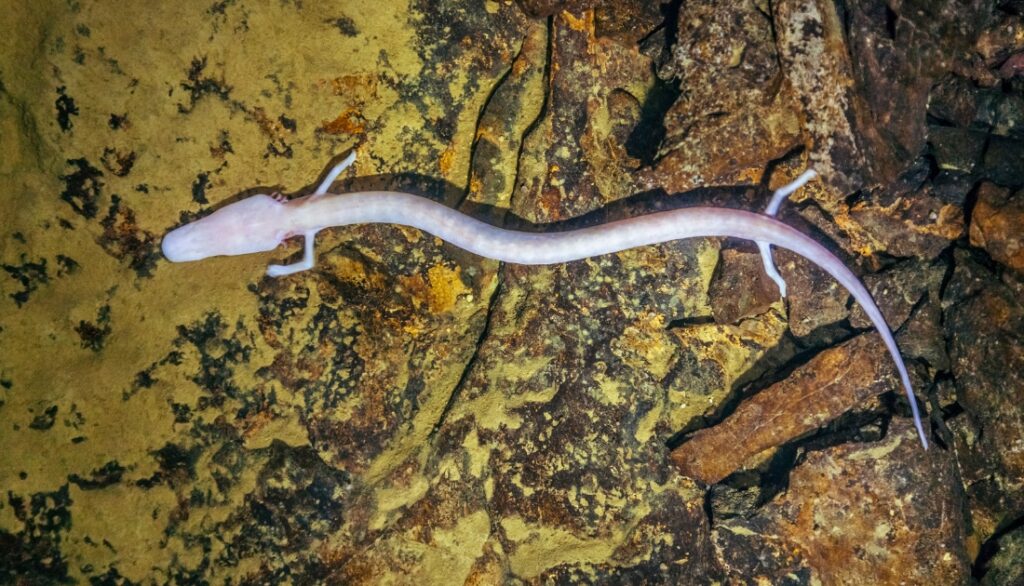
Unfortunately, the Olm population faces threats such as habitat disturbance, pollution, and changes in water flow. Conservation efforts focus on preserving their unique habitats and raising awareness about the importance of protecting these subterranean marvels, ensuring their continued existence in the hidden depths of the karst landscape.
11. Sirens
Sirens are aquatic salamanders known for their elongated bodies and lack of hind limbs. These unique amphibians possess external gills throughout their lives, allowing them to breathe underwater.
Often found in slow-moving or stagnant waters, sirens have a remarkable ability to regenerate various body parts, including their limbs and external gills. Their eel-like appearance and distinct features contribute to their adaptation to aquatic environments. Despite their legless nature, sirens are adept swimmers and play a crucial role in aquatic ecosystems.
12. Eastern Red-Spotted Newts
Eastern Red-Spotted Newts, known scientifically as Notophthalmus viridescens, are fascinating amphibians with distinct life stages. They start as aquatic larvae, then transform into terrestrial juvenile “efts,” and finally become fully aquatic adults. During the eft stage, they display striking red-orange spots on a dark background, serving as a warning to predators about their toxicity.
These newts produce toxins in their skin, making them unpalatable to many predators. However, these toxins are not harmful to humans unless ingested. The bright coloration is a form of aposematism, signaling their toxicity to potential threats.
13. Yellow-Bellied Toads
The Yellow-Bellied Toad (Bombina variegata) is a small, brightly colored toad found in parts of Europe and Asia. Known for its distinctive yellow or orange underside, it secretes toxic substances from its skin as a defense mechanism against predators.
These toads are primarily terrestrial but are associated with wet habitats, breeding in shallow waters. They exhibit a unique behavior known as “unken reflex,” where they arch their backs and expose their bright bellies when threatened. The yellow-bellied toad’s vibrant coloration serves as a warning to potential predators about its noxious skin secretions.
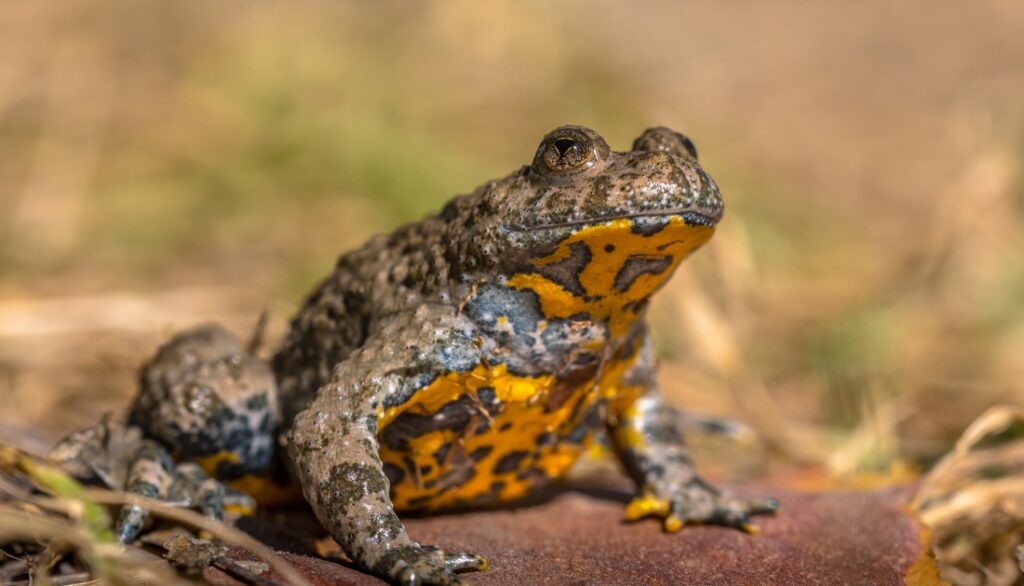
14. Koolasuchus cleenlandi
Koolasuchus cleelandi was a large amphibian that lived during the Early Cretaceous period in what is now Australia. It belonged to a group of amphibians known as temnospondyls. Koolasuchus had a robust body and short limbs, indicating a primarily aquatic lifestyle. It likely inhabited freshwater habitats, such as swamps and rivers. This species is notable for its unique adaptations to the Australian environment and provides valuable insights into the diversity of prehistoric amphibians.
15. Labyrinthodon
Labyrinthodon, an extinct group of amphibians from the Triassic and Jurassic periods, boasted a robust build and distinctive tooth structure, earning its name, which means “maze tooth.” These creatures were adaptable, thriving in both aquatic and terrestrial environments. With fossilized footprints and varying species sizes, Labyrinthodon provides a fascinating glimpse into prehistoric amphibian diversity and the environmental changes they navigated before their eventual extinction.
